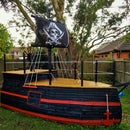Introduction: Captain America Shield
I've always wanted to buy myself Cap's shield but never had the money to do so. I thought I could give myself a challenge and make one from scratch! Living in the UK I unfortunately do not have access to a "flexible flyer sled" (which seemed to be the best option), so I found a different way to make myself a full scale, full metal, heavy duty Captain America Shield!
Shield Specs...
Diameter: 66cm (26")
Mass: 7.4Kg (16lb)
Material: Steel
Total Cost: about £55 ($70)
Step 1: Tools and Materials
Here is a list of some of the things you will need for the project; all of the items are variable and do not need to be the exact same product, these are just the ones I personally bought when making my shield.
- 1x Steel fire pit "Kloepperboden" was the name of the one I bought ( mine was 81cm which was just big enough as I cut some off for the build, this is the most expensive part of the build, I bought mine from Amazon for around £35).
- 12x 6mm Chicago screws-Silver ( I bought a pack of 20).
- 2x Spray paint - 1x Red, 1x Blue ( I bought "Metal-cast Anodizing Colour Coat", any other paints with the same finish will do, they do not have to be anodizing although they need to be metal paints!).
- Clear coat spray paint ( I went to Halfords and bought some clear Lacquer).
- 3 or 4 brown faux-leather or leather belts.
- Sheet steel 2-3mm ( about a quarter of a square metre)
- Masking tape.
- Flexible painters tape.
- Twisted wire brushes for electric screwdrivers/drills.
- An electric screwdriver/drill.
- An angle grinder ( with metal cutting discs).
- A selection of metal drill bits.
- Large compass ( or you can just use a pin and a piece of string)
- Scissors, Marker pens, Tape measures, the general stuff!
- LOTS AND LOTS OF PATIENCE!
Step 2: Cutting and Preparing the Metal Dome
The fire pit itself weighed around 16Kg before cutting it to size, it eventually only weighed around 7Kg once cutting off the rim. I started by finding a centre point on the underside of the fire pit and marked it with a marker pen ( this mark will be used to make all further measurements and lines so make sure it is easily visible ). I drew a circle of radius 33cm by placing a piece of Blu-Tack on the centre point and burying a pin in it, then tying a piece of string round the end of the marker pen, and a knot 33cm from the pens tip. Placing the knot over the upturned pin allowed me to draw a perfect circle, I further used this technique when making lines for painting the inner circles.
I took an angle grinder to the fire pit making sure as not to scratch in inner piece as a mistake will be visible on the shield. Be careful to stay on the outside of the line you have drawn and not to go too quickly as the disc will disintegrate. Using the edge of the cutting disc I later cleaned up the sharp edges and used a file to make them as smooth as possible.
A fire pit is coated with heat proof, scratch proof, waterproof paint, to remove I used a wire brush on an electric screwdriver to scratch the paint off the steel below, this also gave a really nice brushed metal finish. This is the most time consuming part of the build, it took me a few weekends to get this done as the paint was really tough. However I am very pleased with the finish that came from it. When taking the paint off, I kept the drill pointed towards the central mark, this made the tiny scratches in the metal seem to move in a circle from the central point.
If the metal is left for a few days without sealing it can rust. To prevent this I sprayed a few coats of clear lacquer to both sides of the shield.
Step 3: Straps and Brackets
Looking at reference for the real movie prop, the shield has a strapping system comprised of two main straps, (Hand and Forearm) and 4 support straps. The straps are fixed to the shield via another piece of metal welded to the inside of the main dome.
I drew out plans to the correct size of my shield and transferred these two shapes onto sheet steel. I again cut the steel with the angle grinder and drilled a series of holes in a row around the edge of the shapes imitating rivets from the movie prop. Then I cut 12 strips of steel measuring 1cm wide and bent them to the desired shape using a hammer and a vise; these pieces were then welded onto the two brackets made previously ( a well executed weld is plenty strong enough to support the full weight of the shield ). Once completed the two brackets can be welded onto the inside dome of the shield making sure they are parallel and about 3cm from the edge of the shield.
The straps were made using faux leather belts, you can cut the belts to the desired size and use a drill to make holes in the belts for the Chicago screws. The four support straps can be simply folded over the bracket straps and fixed using two screws. The two main straps are slightly harder to fix, using the belt buckle from the old belts they can be threaded and fixed as in the picture above; these two straps are then adjustable. ( I would suggest making one strap larger than the other; one large enough for your forearm and and the other for your hand )
Step 4: Painting
Now for the fun part! The shield is finished with two rings of red and a blue circle around the centre star. The radii from the central point to each of the circles are as follows...
(Centre)
-----------------------] 12cm
------------------------------------] 19cm
-----------------------------------------------] 26cm
----------------------------------------------------------] 33cm (Edge)
Note: These measurements were taken along the curve of the shield.
After drawing a circle at each of these intervals, place masking tape on the inside of the line, the aim is to cover all parts of the shield that will not be painted red. Start with the thin flexible painters tape, follow the line making sure the tape travels in a smooth continuous curve as any odd angles will show once painted. Next use standard size masking tape to line the flexible thin tape, ensure there are no gaps between the tapes. And finally cover up the rest of the gap with more masking tape, make sure all the edges are firmly pressed to the shield so paint will not reach under.
To paint the shield, read the instructions on the can as they may differ on the paint choice, going in 2-3 light layers is always better than one thick layer, this will give the best result. After the paint is dry the masking tape can be removed slowly and carefully.
The same taping process can now be used to cover the three outer rings ( red, silver, red ) paper or newspaper can be used to cover the large parts of the shield to save tape ( see image above ). To mark the star mark 5 points on the masking tape ring at 72 degree intervals from the central point. From here the points can be connected using masking tape. IMPORTANT, make sure the outside edge of the masking tape converges just as it reaches the start of the circle ( again see picture above, this may require the masking tape to be cut at odd angles )
Finally, paint the remaining section blue just as you had done with the red paint and leave to dry. Once the paint is dry and the masking tape removed, give the while shield a couple layers of clear coat paint to seal it and you're done!!!
I am really pleased with how well my shield came out and it is ideal for this years Halloween costume and i will later display it on my wall for all to see! I had great fun making this project and am very happy with my result.
If you have any questions please ask in the comments!
Marco






